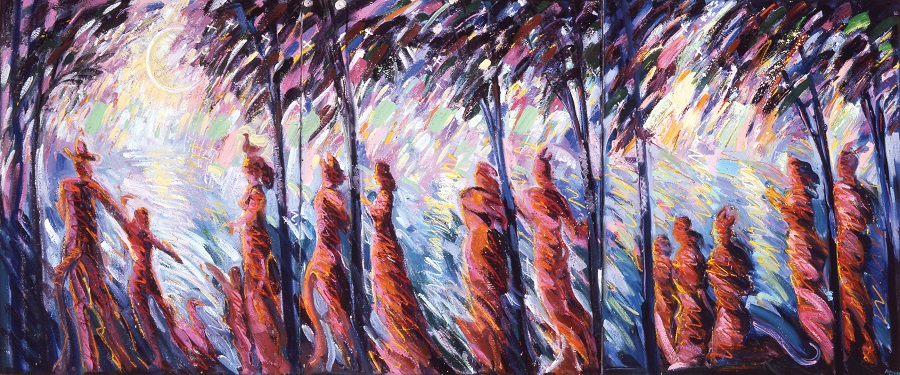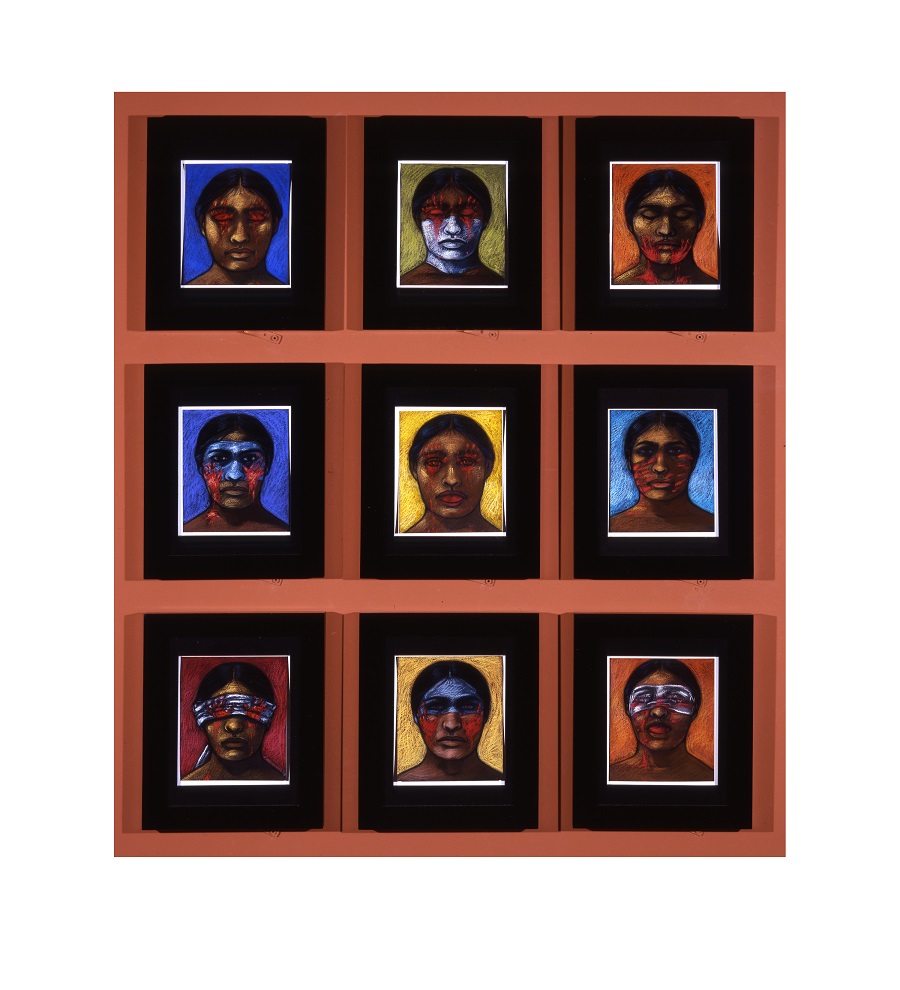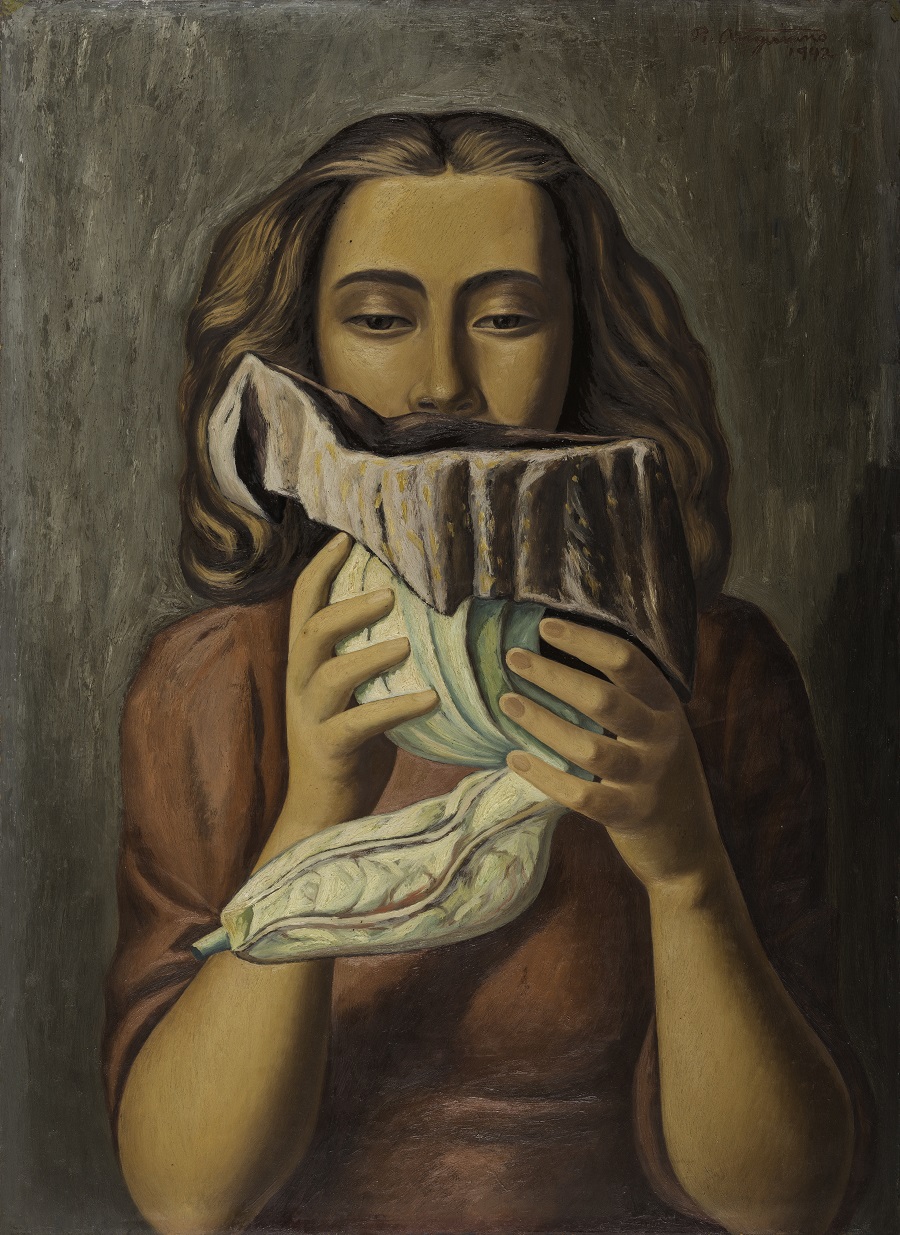
Image of oil painting on canvas by Carlos Almaraz (Mexico / US, 1941-1989), Moonlight Myth / Mito de claro de luna (Mito de luz de luna), 1985 courtesy of MOLAA.
Two new summer exhibitions at the Museum of Latin American Art (MOLAA) are setting a new precedent for the institution founded on the premise of educating the American public about contemporary Latin American fine art. What began as MOLAA founder Robert Gumbiner’s mission in 1996 to expose the public to these works has now been revised to include artists of Latin American descent who have also lived and worked in various other countries.
Miradas: Ancient Roots in Modern and Contemporary Mexican Art celebrated its opening on July 17 and will be open through September 27. The exhibit features works by artists of Mexican descent, most notably artists from both sides of the border.
Curator of Exhibitions Edward Hayes Jr. told the Post that just over a year ago, MOLAA decided that their mission to exclusively showcase the work of artists who had lived and worked in Latin America needed to be revisited. MOLAA decided to expand its mission to pursue Latino and Chicano art, as well.
“This is the first big step we’ve made on that promise,” he said of Miradas.
“It wasn’t that he wanted to exclude Chicanos or Latinos or anybody else,” said Susan Golden, media director for MOLAA. “When Dr. Gumbiner founded the museum, he focused on Latin American [art] because he had traveled there and realized nobody here knew anything about it, nobody here knew those artists.”
Golden says that nowadays, so many Latin American artists are spending years abroad in Europe or in the United States, that it’s simply too restrictive for the museum to exclude, for example, Diego Rivera’s life and work when he lived in Paris for nearly 14 years before returning to Mexico.
“Being restrictive is never a good idea,” she said. “Art is fluid, artists are fluid and of all the people in the world I think artists travel the most.”
While Miradas is not the first exhibition at MOLAA to show works by Latino and Chicano artists, the Pacific Standard Time exhibition MEX/LA: Mexican Modernism(s) in Los Angeles, 1930-1985 in 2011 also exhibited such works. However, Golden iterated that Miradas is the first major display of the museum’s commitment to this revamped purpose.
Golden pointed to an astounding, colorful oil painting (pictured above) by Carlos Almaraz, an artist who was born in Mexico then moved with his family to the United States to settle finally in East Los Angeles. He was a founding member of the Chicano art collective Los Four and became involved in César Chávez’s farm workers’ movement, Luis Valdez’s Teatro Campesino, and Mechanicano, a cooperative gallery in East Los Angeles, according to the Smithsonian American Art Museum.
Moonlight Myth / Mito de claro de luna (Mito de luz de luna) is an expressive piece to say the least, and would not have been included had MOLAA not opened its doors a little wider to include an artist of Mexican descent who had lived and worked in the states.

Image of pastel on paper work by Judithe Hernández (USA, b. 1945), Mano colorada, mano de sangre, mano de opresión / Red Hand, Bloody Hand, Hand of Oppression, 2008 courtesy of MOLAA.
The exhibition features nearly 100 paintings, prints and photographs drawn from the Bank of America Collection. Originally curated by Cesáreo Moreno of the National Museum of Mexican Art in Chicago in collaboration with Bank of America’s curatorial staff, Miradas showcases a survey of artwork created over the past 80 years by artists of Mexican descent who documented the culture they observed, on both sides of the border.
According to MOLAA, Miradas sticks to the philosophy of Cultura Sin Fronteras (culture without borders) and seeks to point out and examine some common artistic tendencies developed since the end of the Mexican Revolution. Featured artists include Diego Rivera, Gabriel Orozco and David Alfaro Siqueiros, as well as American artists Judithe Hernandez and Luis Jiménez Jr.
“They’re ahead of the game,” said Hayes Jr. about the Bank of America collection. “Some museums are catching up to them and we’re right there with them in having a more integrative approach to Latin American art.”
Alongside Miradas, Raúl Anguiano: Retrato de un Maestro is another new exhibition that will be on display through September 27.

Image of Flor de pato, 1942, Oil on Masonite, courtesy of MOLAA.
Hayes Jr. says the collection is the museum’s attempt to showcase the work of an artist who is “maybe underrecognized.” He described Anguiano as an artist who is “a little under the radar.”
“He’s considered a second-generation muralist, but his work is pretty incredible and we’re lucky to have all his work here from his widow,” he said. “It’s a private, family collection[…] Instead of seeing big murals, we’re seeing family portraits, we’re seeing intimate works, surrealist sketches[…]”
Visitors will have the chance to see 35 paintings and works on paper created by the Mexican-born artist during the 1930s and 40s. According to the release, In 1940, Anguiano studied at The Art Students League in New York, while his time in the city led him to begin a series of realist paintings. And while his first solo exhibition was Raúl Anguiano y Máximo Pacheco at the Palacio de Bellas Artes in Mexico City in 1935, he went on to exhibit in countries worldwide, including Brazil, Chile, France, Germany, Israel, Japan, Italy and the United States.
Drawn from Brigita Anguiano’s private collection, these early works reflect the artist’s participation in traditional genres of portraiture and landscape painting and reflect his explorations of Cubism, Realism and Surrealism, according to the announcement.
Hayes Jr. says that he hopes those who take the time to see Miradas and Raúl Anguiano will leave with an interest in perhaps one or two new artists they had never heard of beforehand.
“It’s a ton of artists, you’re not going to remember everything,” he said. “You’re going to leave here and a couple things are going to stick. There’s almost a hundred works in this exhibition, there’s a ton of big names and then some names that you probably haven’t heard of so I hope that people walk out of here with a new name in their head. Like, ‘Hey look I really liked that, let me go look them up.’”
For those interested in a deeper look into Miradas, on Sunday, August 16, Judithe Hernández, described as one of the pioneering artists of the Chicano Art and Los Angeles Mural Movement of the 1960s and 70s, will discuss her work showcased within the exhibition at 3:00PM.
Visit MOLAA during open hours Sunday, Wednesday, Thursday and Saturday from 11:00AM to 5:00PM and on Friday from 11:00AM to 9:00PM. General admission is $9, $6 for students with an ID and for seniors who are 65 years and older. Members and kids under 12 are free. Admission is free for everyone on Sundays sponsored by Target. For more information about MOLAA, click here.
{FG_GEOMAP [33.7744158,-118.1798784] FG_GEOMAP}

